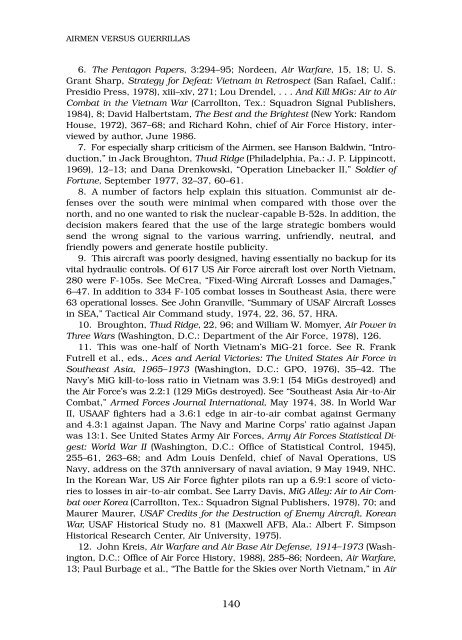Archie to SAM: A Short Operational History of Ground-Based Air ...
Archie to SAM: A Short Operational History of Ground-Based Air ...
Archie to SAM: A Short Operational History of Ground-Based Air ...
You also want an ePaper? Increase the reach of your titles
YUMPU automatically turns print PDFs into web optimized ePapers that Google loves.
AIRMEN VERSUS GUERRILLAS<br />
6. The Pentagon Papers, 3:294–95; Nordeen, <strong>Air</strong> Warfare, 15, 18; U. S.<br />
Grant Sharp, Strategy for Defeat: Vietnam in Retrospect (San Rafael, Calif.:<br />
Presidio Press, 1978), xiii–xiv, 271; Lou Drendel, . . . And Kill MiGs: <strong>Air</strong> <strong>to</strong> <strong>Air</strong><br />
Combat in the Vietnam War (Carroll<strong>to</strong>n, Tex.: Squadron Signal Publishers,<br />
1984), 8; David Halbertstam, The Best and the Brightest (New York: Random<br />
House, 1972), 367–68; and Richard Kohn, chief <strong>of</strong> <strong>Air</strong> Force His<strong>to</strong>ry, interviewed<br />
by author, June 1986.<br />
7. For especially sharp criticism <strong>of</strong> the <strong>Air</strong>men, see Hanson Baldwin, “Introduction,”<br />
in Jack Brough<strong>to</strong>n, Thud Ridge (Philadelphia, Pa.: J. P. Lippincott,<br />
1969), 12–13; and Dana Drenkowski, “Operation Linebacker II,” Soldier <strong>of</strong><br />
Fortune, September 1977, 32–37, 60–61.<br />
8. A number <strong>of</strong> fac<strong>to</strong>rs help explain this situation. Communist air defenses<br />
over the south were minimal when compared with those over the<br />
north, and no one wanted <strong>to</strong> risk the nuclear-capable B-52s. In addition, the<br />
decision makers feared that the use <strong>of</strong> the large strategic bombers would<br />
send the wrong signal <strong>to</strong> the various warring, unfriendly, neutral, and<br />
friendly powers and generate hostile publicity.<br />
9. This aircraft was poorly designed, having essentially no backup for its<br />
vital hydraulic controls. Of 617 US <strong>Air</strong> Force aircraft lost over North Vietnam,<br />
280 were F-105s. See McCrea, “Fixed-Wing <strong>Air</strong>craft Losses and Damages,”<br />
6–47. In addition <strong>to</strong> 334 F-105 combat losses in Southeast Asia, there were<br />
63 operational losses. See John Granville, “Summary <strong>of</strong> USAF <strong>Air</strong>craft Losses<br />
in SEA,” Tactical <strong>Air</strong> Command study, 1974, 22, 36, 57, HRA.<br />
10. Brough<strong>to</strong>n, Thud Ridge, 22, 96; and William W. Momyer, <strong>Air</strong> Power in<br />
Three Wars (Washing<strong>to</strong>n, D.C.: Department <strong>of</strong> the <strong>Air</strong> Force, 1978), 126.<br />
11. This was one-half <strong>of</strong> North Vietnam’s MiG-21 force. See R. Frank<br />
Futrell et al., eds., Aces and Aerial Vic<strong>to</strong>ries: The United States <strong>Air</strong> Force in<br />
Southeast Asia, 1965–1973 (Washing<strong>to</strong>n, D.C.: GPO, 1976), 35–42. The<br />
Navy’s MiG kill-<strong>to</strong>-loss ratio in Vietnam was 3.9:1 (54 MiGs destroyed) and<br />
the <strong>Air</strong> Force’s was 2.2:1 (129 MiGs destroyed). See “Southeast Asia <strong>Air</strong>-<strong>to</strong>-<strong>Air</strong><br />
Combat,” Armed Forces Journal International, May 1974, 38. In World War<br />
II, USAAF fighters had a 3.6:1 edge in air-<strong>to</strong>-air combat against Germany<br />
and 4.3:1 against Japan. The Navy and Marine Corps’ ratio against Japan<br />
was 13:1. See United States Army <strong>Air</strong> Forces, Army <strong>Air</strong> Forces Statistical Digest:<br />
World War II (Washing<strong>to</strong>n, D.C.: Office <strong>of</strong> Statistical Control, 1945),<br />
255–61, 263–68; and Adm Louis Denfeld, chief <strong>of</strong> Naval Operations, US<br />
Navy, address on the 37th anniversary <strong>of</strong> naval aviation, 9 May 1949, NHC.<br />
In the Korean War, US <strong>Air</strong> Force fighter pilots ran up a 6.9:1 score <strong>of</strong> vic<strong>to</strong>ries<br />
<strong>to</strong> losses in air-<strong>to</strong>-air combat. See Larry Davis, MiG Alley: <strong>Air</strong> <strong>to</strong> <strong>Air</strong> Combat<br />
over Korea (Carroll<strong>to</strong>n, Tex.: Squadron Signal Publishers, 1978), 70; and<br />
Maurer Maurer, USAF Credits for the Destruction <strong>of</strong> Enemy <strong>Air</strong>craft, Korean<br />
War, USAF His<strong>to</strong>rical Study no. 81 (Maxwell AFB, Ala.: Albert F. Simpson<br />
His<strong>to</strong>rical Research Center, <strong>Air</strong> University, 1975).<br />
12. John Kreis, <strong>Air</strong> Warfare and <strong>Air</strong> Base <strong>Air</strong> Defense, 1914–1973 (Washing<strong>to</strong>n,<br />
D.C.: Office <strong>of</strong> <strong>Air</strong> Force His<strong>to</strong>ry, 1988), 285–86; Nordeen, <strong>Air</strong> Warfare,<br />
13; Paul Burbage et al., “The Battle for the Skies over North Vietnam,” in <strong>Air</strong><br />
140
















